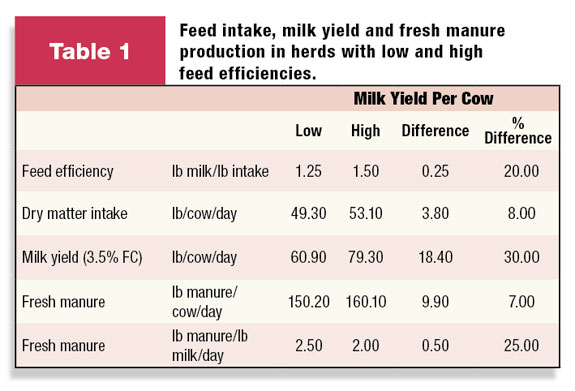Feed efficiency can be defined as the amount of milk produced per unit of feed intake during a normal lactation, and will be affected by bodyweight changes and environmental factors (e.g. heat stress).
For this reason, it is recommended to obtain an annual average of feed efficiency by keeping records of total milk output, including on-farm milk consumed, and cow intake (adjusted for refusals). To obtain more reliable numbers, total milk yield and cow intake should be adjusted. The milk yields should be adjusted for 3.5% fat-corrected-milk and the intake by dietary dry matter content.

Information on dry matter intake, milk yield, and estimations on fresh manure production were obtained from a survey of 40 dairy farms in Merced County, California. Dairy farms were divided into two categories, low milk yield and high milk yield (see Table 1 ), according to DHI information.
Feed intake per farm was calculated for each lactating group based on the total daily amount of TMR supplied, divided by the number of cows in each feeding group, and corrected by estimated refusals.
Fresh manure production for lactating cows was estimated based on the equation from J. of Dairy Sci. Vol. 88(1):3721, as follows: Manure Excretion (kg/cow per day) = Dry Matter Intake (kg/cow per day) 2.63 + 9.4. (Note: values in Table 1 were converted from kg to pounds by multiplying by a factor of 2.2).
The results in Table 1 show differences in dry matter intake, milk production and manure production between herds with high and low feed efficiencies. Herds with high feed efficiency consumed 8% more dry matter, yielded 30% more milk per cow, and produced 7% more manure per cow per day; however, these cows produced 25% less manure per lb of milk.
Data shown in Table 1 can easily be used to estimate net income changes using diet prices, manure management costs, and milk price. The increment of milk should be evaluated against the increase in cost of feed intake and the savings in manure management costs (energy and labor). PD
References omitted due to spacebut are available upon request by sending an email to editor@progressivedairy.com .
â Excerpts from University of California Cooperative Extension Dairy Newsletter, May 2010

-
Alejandro Castillo
- Farm Adviser
- Dairy Science
- Email Alejandro Castillo





